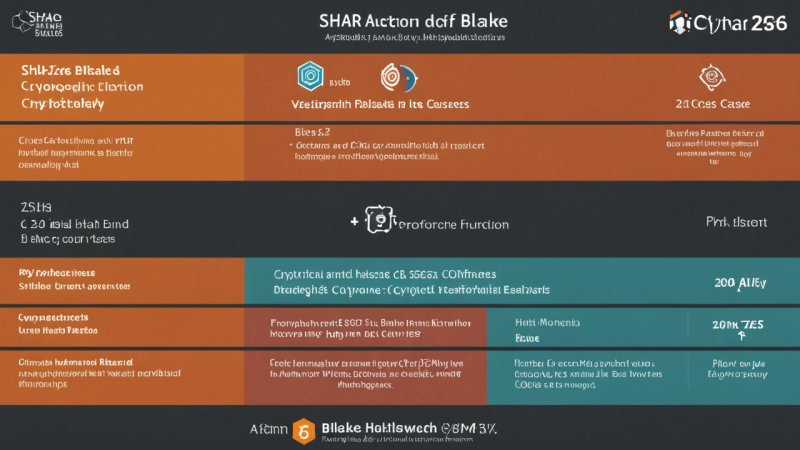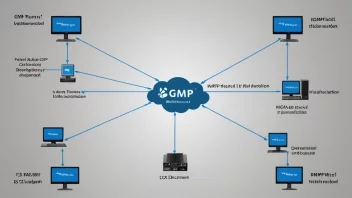In the world of cryptography, hash functions play a pivotal role in ensuring data integrity, security, and compliance with data protection laws. Among the myriad of hashing algorithms available, two have gained significant attention: SHA-256 and BLAKE2. In this article, we will delve into a detailed comparison of these two hash functions, exploring their strengths, weaknesses, and practical applications.
Understanding Hash Functions
Hash functions are algorithms that take an input (or 'message') and return a fixed-size string of bytes. The output is typically a digest that represents the input data. The primary properties of a good hash function include determinism, quick computation, pre-image resistance, small changes in input leading to significant changes in output, and collision resistance.
Overview of SHA-256
SHA-256 (Secure Hash Algorithm 256-bit) is part of the SHA-2 family, which was designed by the National Security Agency (NSA) and published by the National Institute of Standards and Technology (NIST). It produces a 256-bit hash value and is widely used in various security applications and protocols, including SSL, TLS, and blockchain technology.
Pros of SHA-256
- Security: SHA-256 is considered secure and resistant to attacks, making it a reliable choice for cryptographic applications.
- Widely Adopted: Its integration into major protocols and technologies, including Bitcoin, establishes its credibility.
- Standardization: As a NIST standard, it is well-documented and vetted by the cryptographic community.
Cons of SHA-256
- Performance: SHA-256 is slower compared to some modern hashing algorithms like BLAKE2, especially in hashing large datasets.
- Power Consumption: Its computationally intensive nature may lead to higher power consumption on devices, which can be a concern for IoT applications.
Overview of BLAKE2
BLAKE2 is a cryptographic hash function that was designed to be faster than MD5, SHA-1, and SHA-2 while maintaining a high level of security. It comes in two variants: BLAKE2b, optimized for 64-bit platforms, and BLAKE2s, optimized for smaller architectures.
Pros of BLAKE2
- Speed: BLAKE2 is significantly faster than SHA-256, making it suitable for applications requiring high performance.
- Flexibility: It offers various output sizes, allowing developers to choose the hash length that fits their needs.
- Security: BLAKE2 is designed with modern cryptographic standards in mind, providing strong resistance against attacks.
Cons of BLAKE2
- Less Adoption: While gaining popularity, BLAKE2 is not as widely adopted as SHA-256, which may affect its acceptance in legacy systems.
- Less Familiarity: As a newer algorithm, some developers may not be as familiar with it, leading to potential implementation errors.
Performance Comparison
When it comes to performance, BLAKE2 outshines SHA-256 in most benchmarks. BLAKE2's design allows it to process data faster, which is crucial in high-load environments where speed is a priority. For instance, in scenarios involving large datasets or real-time applications, BLAKE2's efficiency can lead to significant performance gains compared to SHA-256.
Use Cases
Both SHA-256 and BLAKE2 have distinct use cases that highlight their strengths:
SHA-256 Use Cases
- Blockchain: SHA-256 is the backbone of Bitcoin's proof-of-work mechanism, ensuring security and integrity of transactions.
- Secure Communication: It's widely used in SSL/TLS protocols for securing communications over networks.
- Data Integrity: SHA-256 is commonly employed in verifying data integrity in software distribution and file storage.
BLAKE2 Use Cases
- High-Performance Applications: BLAKE2 is ideal for applications requiring fast hashing, such as password hashing and data deduplication.
- IoT Devices: BLAKE2's low power consumption makes it suitable for resource-constrained devices.
- Data Integrity Checks: The flexibility in output size allows BLAKE2 to be used in various scenarios, including file integrity verification.
Case Study: Blockchain Implementation
To illustrate the practical differences between SHA-256 and BLAKE2, consider their implementation in blockchain technology. Bitcoin, which uses SHA-256, showcases the algorithm's strength in ensuring transaction security and maintaining the integrity of the blockchain. Conversely, newer blockchain projects seeking faster transaction speeds and lower energy consumption might opt for BLAKE2. For instance, projects that focus on user experience and efficiency could benefit from BLAKE2's superior performance.
Conclusion
In conclusion, both SHA-256 and BLAKE2 have their unique advantages and disadvantages. SHA-256's long-standing reputation and broad adoption make it a secure choice for critical applications, especially in blockchain technology and secure communications. On the other hand, BLAKE2 offers remarkable speed and flexibility, making it well-suited for high-performance applications and resource-constrained environments. Ultimately, the choice between these two hash functions should be guided by the specific requirements of the application, balancing security needs with performance considerations.






